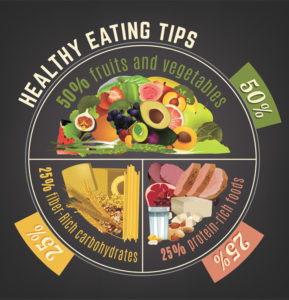 The formula for weight loss sounds simple: You need to burn more calories than you take in. That usually means moving more and eating less.* But does the thought of cutting back on what you eat leave you, well … hungry?
The formula for weight loss sounds simple: You need to burn more calories than you take in. That usually means moving more and eating less.* But does the thought of cutting back on what you eat leave you, well … hungry?
Here’s a secret: You may not have to do anything drastic. Consider this three-step, no-diet, no-denial approach from UnitedHealthcare Florida’s chief medical officer, Dr. Mayrene Hernandez. It may help you shave calories on your way to weight-control success:
Step 1: Examine and plan
Play detective. Record what you eat and drink every day — for about a week — in a food diary. You can make your own — or use an app. Then look over your entries — and note essentials and extras. Essentials are foods that give your body energy and nutrients. These are healthy items such as fruits, veggies, whole grains, low-fat dairy products and lean sources of protein. Extras are often sugary or fatty foods with few nutrients. You don’t have to give up these treats entirely. But ask yourself how you might cut back; sharing a dessert or French fries, switching to single serving bags are two easy ways to cut calories in half (or more).
Preparing a shopping list in advance and including healthy snack items helps manage spontaneous shopping. Also look for individual portion sizes, which while may cost a little more, are more effective in helping cut calories, encourage mindful eating and avoid the eating out of the big bag or box habit.
Having a visual such as what a healthy plate looks like posted on your refrigerator, along with keeping a diary and/or tracking what you eat via a Fitbit type watch or app, are effective tools to find ways to improve what you eat and whittle away calories.
Rethink how you eat. Do you finish your child’s leftovers? Nibble nonstop at work? Overindulge when you’re stressed? Try to identify times you eat when you’re not truly hungry. Think of ways you can switch up your behavior. Maybe that means having the kids clear the table, packing nutritious bites in small portions for work or making a cup of tea instead of grabbing a sugary soda when you feel tension rising.
Shop smart. Head to the grocery store with a list of healthy foods in hand. And don’t go in hungry. Shop after a meal or hearty snack, when goodies are less likely to tempt you.
Step 2: Trim at the table
Downsize dishes. Dish up your meals onto smaller plates or bowls. You’ll still feel like you’re getting plenty. But the portions will stay modest. This trick can work for beverages too.
Savor the flavor. Enjoy every bite — and eat slowly. It gives your mind time to get the message that your stomach is full.
Step 3: Be a savvy snacker
Tap into water. Drink up throughout the day. Quenching your thirst first may help take the edge off hunger.
Aim for eight 8 oz, glasses per day, one upon rising, one before each meal or snack and then a couple throughout the day and you have met your goal!
Before hitting the cookie jar or bag of chips, drink a big glass of water. Often times, what you may think is hunger is actually more attributable to being thirsty. Aim for eight 8-oz glasses or six 12-oz bottles per day (try to use reusable bottles) and try replacing at least one sugary soda or juice with water instead. Add in slices of lime, cucumber or lemon to add some flavor.
Ready yourself for snack attacks. You don’t have to give up between-meal munchies. Just have healthy options on hand, such as whole fruit, fresh veggies, or plain popcorn with a little garlic powder or your favorite salt-free seasoning.
Unpack your bags. Do you sometimes eat straight from a package of crackers, nuts or chips? Even if you make a healthy choice, it’s easy to lose track of how much you’ve had. So serve yourself a small portion — and put the package away. Or pack up single servings in small baggies or containers that you can grab on the go.
For more free tips on healthy eating and living, visit www.uhc.com/health-and-wellness.
*For general good health, most people should aim for at least 2.5 hours of moderate-intensity physical activity a week. But to lose pounds or maintain a weight loss, you may need more. Ask your doctor what your goals should be. For safety’s sake, talk with your doctor before significantly increasing your activity level.
www.uhc.com
Check Also
CUSTOMIZABLE LIGHT ADJUSTABLE LENS A GAMECHANGER FOR CATARACTS PATIENTS
All Americans have some degree of cataract change by the age of 75. As the …
 Central Florida Health and Wellness Magazine Health and Wellness Articles of the Villages
Central Florida Health and Wellness Magazine Health and Wellness Articles of the Villages



